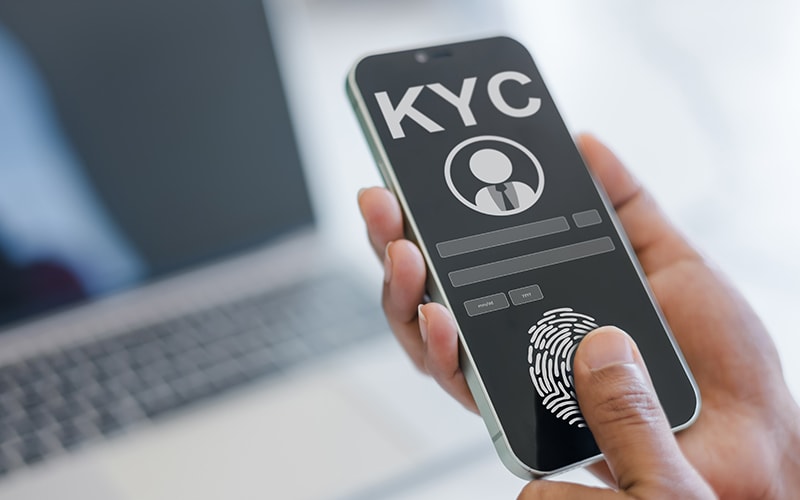KYC regulations require financial services providers to identify the customer, verify their authenticity and understand what their sources of income are. This helps the institution manage risks, protect stakeholders and protect against money laundering. Apart from verifying a customer’s ID proofs, a critical component of KYC is a face-to-face meeting with the customer. This in-person verification (IPV) helps authenticate the customer and establishes a sense of trust.
However, with a pandemic such as COVID-19, a face-to-face meeting puts both the customer and the representative at risk. Meanwhile, banks are seeing a massive surge in new small and medium-sized enterprises and private customers looking for financial services — mainly loans — to help them through the lockdown. Investment institutions are also looking to attract new investors as global financial markets have shrunk between 10% and 30%. Yet with lockdowns and social distancing norms expected to be in place for an extended period, meeting a customer to complete the in-person KYC check is nearly impossible.
Video KYC for the COVID-19 era
That’s where fintech startups such as Signzy are helping. “In the past two months, we have had a big spike in queries, and we are starting to win implementations at banks that previously weren’t interested,” said Ankit Ratan, CEO of Signzy, which is trying to revolutionize digital KYC. The 2015-founded firm recently released a sophisticated videoconferencing solution tailored to KYC that can be used by banks that suddenly have a lot of staff working remotely but are under pressure to complete KYC checks.
In-person videoconferencing
Customer onboarding for banks includes two components: verification of a customer’s documents and data, and IPV. While there are many companies and technologies that verify the former with government databases, banks and regulators have struggled with IPV checks that rely on face-to-face interaction.
Figure 1. Customer journey during video KYC process
Signzy aims to resolve just that. It offers a safe and secure IPV process using videoconferencing. But that’s not all. Signzy also integrates its facial recognition and document detection technology with video IPV, a KYC capability that solves the need for human interaction that had remained unresolved for a long time. This allows a bank representative to talk the customer through the process and verify their details in real time while the technology corroborates the data with the appropriate government agency. What’s more, it provides these features in a secure and encrypted environment.
The remote video KYC incorporates optical character recognition-driven data capture that reads the ID proofs while its AI-driven rule engine runs a real-time compliance check against government databases. To prevent fraud, Signzy has put in place multiple checkpoints. The engine checks the customer’s IP address for any proxies or blacklisted IPs and helps geo-tag the customer’s location to ensure that the customer is not spoofing his or her location. The forgery check authenticates a signature’s validity, while image forensics verify the authenticity of the ID proof.
To reduce remote video KYC frauds or spoofing, such as video editing or 3D masks that can mimic an individual, active and passive “liveness” come into play. Active liveness detection includes responses to queries or actions posed to customers. For example, as a safety measure, the platform can pose random questions to the customer by employing a random sampling algorithm. The institution can choose to add any questions that are required, that allows the institution to balance security and user experiences. On the other hand, passive liveness provides a frictionless experience to the customer, since this is a process in which only a customer screenshot is examined and a short video is captured. Signzy enables audit trails and a time stamp on all images and videos that can be used for future reference.
Workflows that save time, effort and money
Signzy allows banks to create workflows and onboarding journeys over a videoconference. It provides onboarding steps to the customer while the video is live, offering the customer a seamless passage through the KYC experience. A checker allows each step to be completed before moving to the next one. With over 150,000 customers onboarded each month by Securities and Exchange Board of India-regulated (an Indian securities regulator) institutions, the platform keeps the customer at the forefront, enabling an onboarding experience that is simple, quick and hassle-free. Its smart queuing platform offers customers a convenient and planned verification method over mobile or the web. Signzy uses iFrame to integrate with a web or mobile application without disturbing the customer’s journey. A step-by-step instruction flow is available to the customer via email, SMS or WhatsApp, providing information at their convenience. As a result, institutions have seen a 50% decline in customer drop-offs, according to Ratan.
Signzy has reduced the life cycle of physical KYC process from 10 days to just four hours |
The platform allows representatives to converse with a customer, verify a customer’s details, take a screenshot, receive customer consent and share documents at the same time.
The life cycle of the physical KYC process can take between eight and 10 days, but with Signzy, that time period falls to just four hours. This leads to efficiency being tripled while lowering the cost of customer onboarding by an astonishing 65%. More importantly, digital fraud can be reduced by 75%.
Figure 2. Signzy's video KYC is more automated, sophisticated and 98% faster than the traditional process
The fintech’s real-time verification solution saves time for institutions and customers. The AI engine immediately matches the customer’s face with the one on the presented ID. Meanwhile, the queuing mechanism helps representatives manage multiple applications simultaneously.
AI-built technology stack
Signzy’s technology stack is heavy on AI, and it has also created a proprietary intelligent engine, VEVA, that processes data captured during the videoconference and performs all the fraud and IP checks. VEVA helps prevent static photo and prerecorded video attacks, using facial passive and active liveness to prevent spoofing. The AI engine also validates the video, verifies the customer’s ID and detects its orientation using machine learning algorithms. AI algorithms run on the ID card images to detect their authenticity by reading pixel layers and generating heat maps.
Financial institutions are known to be finicky when it comes to security, and with good reason. To secure data in motion, Signzy uses a cipher TLS 1.2 channel encryption with a 2048-bit RSA key over a SHA-256. LVM disks are used to host any block store files to ensure the platform is secure and scalable for high-throughput algorithms. Database hardening is done per industry standards, and access rights are given only to the right people. Unwanted personally identifiable information can be deleted, as Signzy has activated the Time to Live (TTL) feature on file storage that deletes unwanted personally identifiable information. On-premises products are deployed as containerized applications that are compiled, tested and security-hardened to form deployable docker images. Signzy ensures that all applications are released after internal and third-party vulnerability assessment and penetration tests are complete.
These additional layers of AI, workflow and security are what Signzy’s spokespeople say sets the company apart from its competitors.
Moving from a domestic to a global market
Signzy is already an established player in India, where the banking and investment regulators have approved its product and where it is one of the largest players. Over 90 Indian clients, including banks, insurers, asset management companies and non-bank financial corporations, use Signzy’s video KYC. KYC has been heavily regulated in India, yet digital KYC has significantly scaled here. And COVID-19 has increased its need — customers that were previously unwilling to move to digital KYC have now quickly embraced it.
Signzy is looking to expand in the American, European and Middle Eastern markets. According to Ratan, regulators in Qatar, Oman and the UAE are more open than before to allow remote onboarding of customers. Ratan also expects strong growth in the American market and has already gone live in the country with Mastercard.
In Signzy’s favor is the ease of implementation of its product. The CEO, Ratan, claims that the implementation cost of videoconferencing is low, and the steps are quite simple because of its plug-and-play feature and platform-agnostic support. In fact, for some of its Middle Eastern clients, Signzy set up the basic infrastructure in a mere 2-3 days. He also indicated that institutions that have a cloud presence can go live much more quickly. To achieve this quick turnaround, he recommends a coordinated effort in three areas:
- Information security
- Application
- Operations
Compliance and information security teams should be involved to begin a process approval as early as possible. As on-premises deployments will be difficult to execute in these times, it would be ideal to have all the requisite cloud deployment approvals in place. Remote-working information security policies also need to be in place for customer-related interactions.
The current situation makes it difficult to carry out new integrations to current applications. Ratan suggests working in two phases. Phase 1 will include the current state, i.e., a workflow that feeds into other applications manually. All new integrations will be carried out in phase 2. He also suggests going live as soon as possible on the cloud, with minimal integrations and moving to an on-premises integrated stack later.
Training and IT support to resolve issues and educate employees must be in place. Audit requirements may change as video recording of the entire process is available. The need for the four-eyes principle is therefore lost. For example, an employee in charge of KYC verification for onboarding will spend less time for IPV because of the AI-driven audit trails. Checker audit processes can be applied programmatically on the video recording. This cuts down the need for an extra step and improves the turnaround time.
Tip of the transformation spear
Whether they are prepared or not, institutions adopting digital onboarding will have to undergo significant organizational changes. It’s not just a matter of adding video KYC; rather, a complete reevaluation of the operating model within the bank is in play. CEO Ankit Ratan thinks that, broadly, the organizational structure will require changes around:
- Rethink: How current job descriptions and duties can be readjusted to adapt to new digital processes.
- Reskill: Training employers to equip their employees with the skills needed to perform new roles required of them.
- Redeploy: Moving employees with specific skills to other parts of the organization where their skills will be more appropriate or useful.
COVID-19 has certainly caught institutions off guard. The current crisis will force them to act faster and think more about implementing digital solutions in the future. As the current COVID-19 situation evolves, financial institutions the world over are more likely to adopt platforms created by companies such as Signzy that can help digitally onboard customers and satisfy KYC requirements swiftly, securely and cost-effectively.







